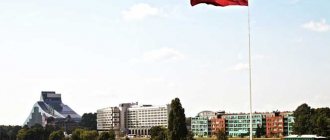The concept of population migration and its role in the modern world
Migration (lat. migratio - relocation) arose at the dawn of humanity. Scientists believe that the first people appeared on the African continent, and subsequently, as a result of migration, they settled throughout the globe. The desire to change places of residence is considered a characteristic feature of humanity. A person who migrates is called a migrant.
The human right to change one's place of residence and move freely is enshrined in the Universal Declaration of Human Rights (Article 13).
In general, migration is the movement of people from one place of residence to another. There are two main types of migration:
- internal;
- external.
Internal migration involves the movement of citizens of one country within its borders. For example, a resident of Barnaul moved to Moscow. He will be an internal migrant. If he leaves the Russian Federation, say, to Germany, he will become an external migrant. Accordingly, external migration implies moving to other countries for a more or less long period, as well as for permanent residence.
Modern scientists determine the main trends and laws of migration processes, which allows not only to understand the causes of certain phenomena in modern society, but also to predict the development of the situation in the future. Today there are more than 30 different definitions of migration. Much depends on the context in which this concept is considered.
The role of migration in the modern world is difficult to overestimate. If we consider migration from a historical point of view, then the modern United States of America, Canada, Australia, New Zealand, and Latin American countries were created precisely by migrants who moved overseas from European countries. Mass labor migration to European countries significantly changed the face of Europe and the ethnic composition of its population.
If we consider the creation and development of the Russian Empire itself, then, for example, the development of lands beyond the Urals was also carried out precisely by internal migrants from its European part, who were able to develop the expanses of Siberia and the Far East.
As a rule, the most common motive for migrants is economic. From time immemorial, people have tried to find for themselves and their loved ones a better place in the sun with more fertile lands, a comfortable climate, with less stringent laws, with the prospect of further development and the realization of their own economic aspirations.
Thanks to migration, powerful industrial centers and agglomerations are being created today. Most of the population growth in modern megacities occurs precisely due to migrants, and not due to the natural increase in the indigenous population of these cities.
Modern economically developed countries are centers of attraction for migrants from economically less developed countries and depressed regions of the world.
Modern economically developed countries are centers of attraction for migrants from economically less developed countries and depressed regions of the world
Factors of population migration
Definition 1
Migration factors are the set of social conditions in which this process occurs and which influence its intensity, volume, direction, as well as other parameters.
Depending on how the influence of certain migration factors on migration processes can be regulated, the following can be distinguished:
- constantly operating, uncontrollable factors: climatic features of the territory, geographical location of the area (seasonal temperature changes, the presence of harmful and dangerous insects, reptiles, etc., swampiness, earthquakes, floods, etc.);
- temporary factors - regulated by indirect influence, changing gradually: age, gender, ethnic composition of the population; level of development of the area, creation of social and industrial infrastructure;
- regulated factors: personnel policy; the presence or absence of certain social benefits; salary increase; changes in national policy; employment and living conditions of the population.
Finished works on a similar topic
- Course work Factors and features of population migration 460 rub.
- Abstract Factors and features of population migration 240 rub.
- Test work Factors and features of population migration 240 rub.
Receive completed work or specialist advice on your educational project Find out the cost
The greatest impact on migration processes is exerted by the “temporary” factor – the composition of the population in terms of length of residence. In territories where the population is growing at a high rate due to migrants, the proportion of non-family men is higher.
The following migration factors are distinguished: positive (pull); negative (pushing).
The determining factors of migration can be both push and pull factors. At the first stage of the migration process, simultaneously with the factors that predetermine the intention to move (push factors), there are factors that determine which specific country or region a person wants to move to (pull factors).
Note 1
If the need to move to a particular region prevails, pull factors are decisive. If the desire to move generally, to any other place, prevails, then push factors prevail.
Do you need to select scientific articles for your academic work? Specify a topic and receive a response in 15 minutes get help
What does the International Organization for Migration do?
The creation of the International Organization for Migration was caused by the chaos and the presence of a multi-million army of displaced persons that arose in Western European countries after the end of the Second World War. Those forcibly displaced as a result of hostilities on the European continent included 11 million people who had different nationalities, nationalities, social status, and so on. Western European countries were flooded with refugees and internally displaced persons, whose fate in the states recovering from the war was something that few people cared about. But the problem was obvious and therefore in 1951 the International Organization for Migration (IOM) was created.
The name of the organization has undergone changes several times. Over the 67 years of its activity, it has transformed from a body performing exclusively technical tasks into the main international organization dealing with migration issues.
A characteristic feature of modern migration processes is the changing structure of migration. Therefore, in the current conditions, the department is faced not only with the problems of refugees as a result of wars and local armed conflicts (for example, in the Middle East), but also with the problems of a significantly increased economic migration traffic.
IOM cooperates with many international organizations, governments of various states, and public organizations in order to streamline migration flows and assist refugees and forced migrants. In addition, IOM's mission includes combating international human trafficking.
Today, 166 countries of the world are full members of the IOM, and 8 states serve as observers. The highest governing body (Council) of the organization is located in Geneva (Switzerland). Today there are more than one hundred main IOM offices around the world. To this number should be added another 400 small branches in various countries.
The International Organization for Migration took an active part in resolving the refugee problem in Europe, which today has not yet been fully resolved. Quotas for accepting refugees by European Union countries were adopted in agreement with the IOM. The European refugee crisis from the Middle East and Africa has become a serious challenge for the organization. Despite its active participation in its resolution, many recognize that this particular crisis showed the organization’s inability to fully confront the challenges of the modern dynamically changing world and fully control the migration flows of the population, in particular from regions affected by armed conflicts.
But at the same time, it was IOM that played a crucial role in helping refugees from civil war-torn Sudan and Ethiopia, whose population was fleeing famine. But this department did not always act so effectively.
Video: the problem of refugees in modern Europe
https://youtube.com/watch?v=9KPPLHLD-kU
The effectiveness of the international migration organization is sometimes questionable. I had the opportunity to visit countries in West Africa that were experiencing the consequences of civil wars and famine. A significant part of the population of these West African countries migrated to other, quieter countries on the continent. In fact, all these migrants were refugees. IOM representative offices operated in Sierra Leone, Liberia, and Guinea. They were contacted by tens and even hundreds of thousands of local residents who wanted to escape war and famine. Under the auspices of the organization, several camps were organized for refugees and internally displaced persons, who received humanitarian assistance and were guarded by a special contingent of UN troops. There were a lot of refugees, so at most every tenth person received real help in the camps. The rest of the refugees were forced to flee on their own, risking their lives by breaking through the borders of neighboring African states or simply going into the jungle for a long time. Many of them died from hunger and wounds received as a result of the repression of civilians carried out by the warring parties in armed conflicts. I did not have the opportunity to be personally present in these countries during the civil wars, but according to multiple eyewitness accounts, assistance to refugees by IOM employees was selective and few people relied on the assistance and real protection of this organization. But I saw the consequences of famine and the Ebola epidemic with my own eyes. IOM took an active part in the delivery of humanitarian aid to the population, but the number of refugees exceeded all acceptable limits, so several hundred employees of the organization could really help only a few. The IOM staff I met were English, Australian, Spanish and Italian. The organization employs representatives of almost all countries that are part of it. In a personal conversation, one Italian told me that his colleagues are well aware that their assistance is a drop in the ocean, which cannot fundamentally change the situation with refugees for the better. In addition, the majority of refugees and internally displaced persons are trying by any means to get into European countries as official refugees, and the governments of these countries are doing their best to counter the influx of such migrants from West Africa. Even under a favorable set of circumstances, accepting refugees will require a decision from the governing bodies of the EU, the adoption of which will take considerable time, because in this case we are talking about a huge bureaucratic machine. Therefore, the organization's relief activities are often limited to targeted humanitarian assistance only.
Under the auspices of the IOM, there are several international research institutes and organizations engaged in research into issues of modern population migration.

The consequences of wars and famine will stimulate Africans to migrate for a long time
Relocation of citizens within the Russian Federation
The settlement of the peoples of Russia and their migration - all this happened especially intensively after the collapse of the USSR, for example, the return of ethnic groups (Ukrainians, Kazakhs, Uzbeks, Balts, Crimean Tatars) to their homeland. The movement of ethnic Russians to Russia, despite government programs, is gradually slowing down. Thus, according to the Ministry of Internal Affairs of the Russian Federation, 118,606 compatriots and members of their families became registered in the Russian Federation in 2021 (for comparison: in 2021 there were 146,585).
The traditional coordinates of migration are gradually coming to the fore: the labor market, urbanization, the education system, personal beliefs.
Analyzing the modern features of migration processes in the Russian Federation, it is worth noting that the picture is by no means rosy, which is facilitated by negative migration and socio-economic trends:
- a significant proportion of illegal immigrants (mainly labor migrants);
- an influx of unskilled labor into large centers with a simultaneous “brain drain” outside the state;
- an increase in crime by foreign citizens, a significant proportion of whom are illegal immigrants;
- excess number of arrivals over departures;
- increase in the number of refugees and.
If you find out what type of migration dominates in Russia at present, the clear answer is internal, with the search for work coming to the fore among its main reasons.
For the Russian Federation, with its territorial scale, the indicators of migration processes vary in different districts depending on climate, resources, industrial capacity, population structure and other factors. For example, if we remember what are the features of migration processes in the Far East, we should point out the huge areas (36% of the country’s territory) and small population (4.4% of the total population). There is a constant outflow of local residents who move to the central and western districts, which is compensated by external migrants.
How do indigenous people feel about immigrants?
Under the existing system of state and social adaptation of migrants, the attitude towards migrants in modern Russia is stereotypically ambiguous. Many see them as a destabilizing factor in the labor market, because “newcomers”, agreeing to work for less pay, become competitors to local residents. Periodically appearing news in the media about criminal offenses involving people of other nationalities only provokes sidelong glances and xenophobic sentiments.
However, if we analyze how the specific direction of migrant flows in Russia has changed in recent years, we see that the number of migrants, for example, from Uzbekistan, Tajikistan and other Central Asian countries, has not changed significantly. This suggests that employers and native residents still tend to be tolerant of representatives of other nationalities and are just as willing to hire them and rent out housing.
Homecoming
There are some categories of citizens whose return to their country of residence occurs “by law” or due to personal convictions. The return of migrants to their homeland for permanent residence is called repatriation.
Categories of citizens covered by repatriation:
- prisoners of war;
- displaced persons;
- refugees;
- forced migrants;
- insured persons if an insured event occurs;
- simply citizens of other countries who live and work in a foreign land.
Read more about the reasons, conditions and features.
In some countries, by the way, programs are being developed to stimulate this process. For example, France and Germany practiced paying material compensation to foreigners who voluntarily quit their jobs and returned to their homeland.
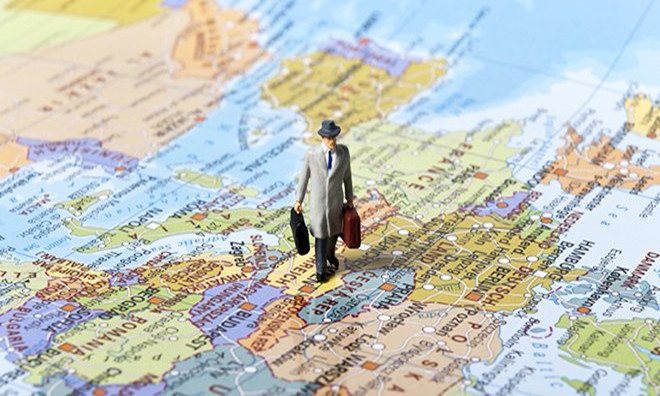
Classification of migration processes
The classification of population migration was adopted to determine the main migration trends, make forecasts for the near and distant future, as well as draw up recommendations to governments to optimize migration traffic and its control. Each category of migration has its own characteristics.
Types
There are several types of migration:
- seasonal tourism;
- seasonal labor;
- urbanization (moving from rural areas to cities);
- ruralization (moving from cities to rural areas, which is especially important for economically developed countries);
- pendulum;
- border;
- temporary or long-term;
- pilgrimage;
- transit.
Forms
The forms of migration can be:
- organized;
- unorganized.
Causes
Scientists involved in the study of migration in the modern world identify several main reasons for migration:
- economic;
- social;
- political;
- demographic;
- cultural;
- military.
Migration is also divided into legal and illegal. The tip of the iceberg that sociologists and immigration experts see often does not reflect the underlying trends. For example, after the introduction of a visa-free regime between the European Union and Ukraine, millions of Ukrainian labor migrants left for EU countries. According to the rules of the European Union, you can stay within its borders for three months every six months. Therefore, millions of Ukrainians go illegally to work in Poland, Germany, the Czech Republic, Spain or, for example, Italy for three months. Only a few of them follow the thorny path of official employment in the European Union. And this huge number of illegal labor migrants is not taken into account by official statistics, since all of them go to Europe officially as tourists or for short-term private trips. In fact, no one asks them at the border about the reasons for leaving for the EU. Therefore, illegal labor migration in some regions of the world is actually much greater than legal migration.
The bulk of modern migrants are economic migrants. There are mixed types, forms or reasons for migration. For example, economic migration can be combined with demographic or political migration.

Flows of migrants are sent to European countries from the Middle East region
The main directions of economic migration today are:
- relocation of unskilled labor from developing Asian and Latin American countries to more developed ones;
- migration within approximately equally economically developed countries that occurs for demographic, social or cultural reasons;
- labor migration traffic from the countries of the post-Soviet space and Eastern Europe to Western European countries, the USA and Canada;
- the relocation of specialists from developed countries to developing ones, which is due to high wages, the desire to travel and professional self-realization.
Some regions of the world are generally unique if you look at them from the point of view of labor migration. For example, in the United Arab Emirates, foreign labor migrants make up more than 90% of all workers, and in Kuwait - 87%.
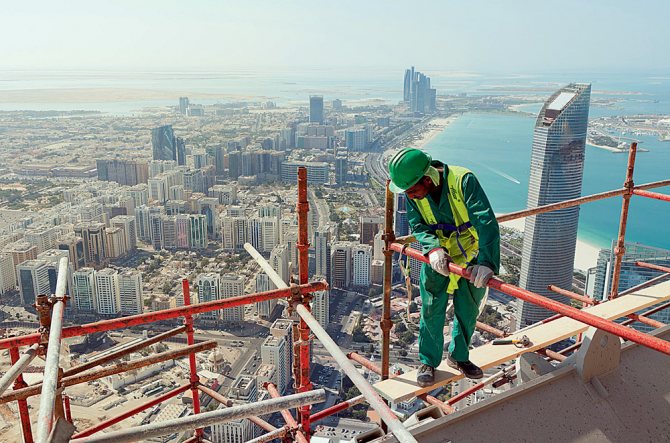
Almost all construction workers in Dubai are foreign labor migrants
Characteristics of modern migration processes
Bibliographic description:
Karpov, A.V. Characteristics of modern migration processes / A.V. Karpov. — Text: immediate // Problems of modern economics: materials of the VII International. scientific conf. (Kazan, March 2018). — Kazan: Young scientist, 2021. — pp. 69-73. — URL: https://moluch.ru/conf/econ/archive/294/13855/ (access date: 05/27/2021).
The article examines the demographic and socio-economic development of territories through the prism of a forecast assessment of permanent and temporary labor migration, which act as components of population compensation and meet the needs of labor resources.
Key words: demography, migration, forecast, population, labor resources.
The article examines the demographic and socio-economic development of the territories through the prism of the predictive assessment of permanent and temporary labor migration, which act as components of population compensation and provide the needs of labor resources.
Key words : demography, migration, forecast, population, labor resources.
Migration is the demographic component that is most difficult to predict, due to the following reasons. Firstly, migration in Russian statistics still remains represented by two components - migration flows for permanent residence and temporary labor migration. At the same time, authorities, including at the municipal level, include only one component in socio-economic development plans - migration for permanent residence, often without reference to the situation on the labor market.
Secondly, the main goal of forecasting population migration in the Omsk region should be to determine the need for labor resources, including through the external component - migration from outside the region. To assess the need for labor resources, fairly detailed information is required on the volumes of supply and demand in labor markets at all levels. The demand for labor can help to estimate the number of vacancies, and the supply of labor resources consists of the population of working age and some other categories of the population that can be involved in the labor market (younger and older than working age, but willing to work). An important component of the labor market is the unemployed population. The shortage of labor resources, which manifests itself in this case, can be covered by internal reserves (usually partially) and by the external component - migration from outside the region. Based on these indicators, the balance of labor resources can be calculated.
One of the most important components of such a forecast is the growth rate of the economy, industrial and agricultural production. These components, along with increased labor productivity, directly determine labor needs. Thus, to forecast the need for labor resources, a whole array of data related to the labor market and the development of the economy of the territory as a whole is required.
Thirdly, to obtain more detailed forecasts of labor demand, including through migration, more advanced statistics regarding employment and labor market issues are required, as well as the availability of detailed plans for the socio-economic development of the territories of the Omsk region. It is required to reflect the future dynamics of the number of employed people not only in the economy as a whole, but also in its individual sectors (primarily in industry as the most significant sector of the regional economy). This will make it possible to calculate labor productivity and determine labor requirements, including through migration. As a rule, long-term plans of municipal districts do not contain information about the dynamics of changes in the number of labor resources and the employed population, not only by industry, but also by municipalities as a whole. Naturally, this does not allow one to calculate labor requirements and determine the role of the migration component.
Taking into account the above, the forecast was based on statistical reports of municipalities of the Omsk region, the analysis of which made it possible to identify the most promising areas, establish and plan the growth rates of their economy, which made it possible to determine (carry out) a typology of the regions of the region and identify groups with similar socio-economic living conditions of the population .
Based on the totality of socio-economic indicators, the group of the most prosperous municipalities of the Omsk region includes the following districts: Azovsky, Isilkulsky, Kalachinsky, Lyubinsky, Moskalensky, Omsky, Tavrichesky, Tarsky.
It is advisable to include in the middle group of promising districts of the region, characterized mainly by an increase in investments in fixed capital and an increase in retail trade turnover: Bolsherechensky, Kormilovsky, Maryanovsky, Nazyvaevsky, Pavlogradsky and Tevrizsky districts. The remaining municipalities in the region are predominantly agricultural and, based on a set of socio-economic indicators, due to the stagnation of the industry, belong to the group of disadvantaged areas of the region. Important, from our point of view, is the indicator of the commissioning of residential buildings, according to which the leaders are the districts of the first group of “prosperous” municipalities. Taking into account the high capital intensity and inertia of the economy, the indicated composition of groups in terms of the “well-being” of the population in the forecast period until 2025, in our opinion, will not change. But this does not mean that there is no need to pursue a targeted demographic policy over a number of years to maintain these positions.
Migration growth over the past two years, as a result of active stimulation of the influx of migrants at the level of local authorities, was observed only in the following districts: Azovsky, Kormilovsky, Lyubinsky, Maryanovsky, Omsky, Sargatsky and Tavrichesky. At the same time, the Sargatsky district was previously defined as “disadvantaged”, and the Kormilovsky and Maryanovsky districts fell into the middle group, which indicates the insufficiency of creating economic prerequisites for the growth of migration growth and the need for a targeted demographic policy at all levels of government with the involvement of business and public organizations.
In order to predict the possible composition of the above migration, namely the share of labor migration, as well as its causes, we will analyze the dynamics of the number of main categories of population of the municipalities of the region over the past 2 years. From the analysis it follows that in almost all municipalities of the Omsk region over the past 2 years there has been an increase in the number of children from 0 to 6 years old (on average by 4%), which can be largely associated with the implementation of measures to support the birth rate at the federal and regional levels authorities.
The increase in the number of pensioners by an average of 3%, as noted earlier, is explained by changes in the gender and age structure of the population, in which numerous post-war generations reach retirement age. At the same time, in most municipalities there is still a slight (on average -0.3%) reduction in the working age population. It can be assumed that in the future, with changes in the age-sex structure, the rate of the described reduction will only increase. However, it should be noted that areas with migration growth due to an active demographic policy were able to ensure an increase in the working-age population over the same period.
Thus, in most districts of the region (except for large ones, for example, the Omsk region), the main reason for the increase in migration numbers is labor migration. At the same time, in the Kalachinsky and Kormilovsky districts, which had a migration increase of 108 and 89 people, respectively, the number of working-age population during the same period decreased by 38 and 28 people, respectively. That is, in these areas, the increase in numbers was achieved due to the migration of the disabled population.
The number of officially registered unemployed during the study period in most districts of the Omsk region decreased, which is a positive fact. However, the data presented do not provide an objective picture of what is happening, since in rural areas the economically active (able-bodied) population is rarely registered at labor exchanges. That is, it is advisable to talk about hidden unemployment here.
The volume of hidden unemployment can be approximately estimated by comparing the indicators of the working-age population with the indicators of the average number of people working in organizations in the context of municipalities of the Omsk region.
At the same time, the majority of the middle-aged population, which makes up hidden unemployment, is engaged in subsistence farming as part of rural households. Young people of working age, who make up hidden unemployment, are mainly engaged in training and advanced training and, in general, are focused on finding work.
Thus, we can make an assumption about the insufficient development of the economy (industry, trade, agriculture) in most municipal districts of the region, which does not allow creating a sufficient number of jobs. To assess the state of the sectors of the national economy represented in the region and the employment of the local population in them, an analysis of the average number of workers by type of economic activity in the regions of the region was carried out.
An analysis of the employment of the population of municipalities of the Omsk region showed that the majority of workers in the region's districts are in the following areas: 1. education - 22.1%; 2. agriculture, hunting and forestry - 21.2%; 3. healthcare and provision of social services - 15.8%. The listed industries are non-productive and, as is known, are subsidized, that is, they require government support and regulation. The largest working population in industrial sectors is represented in several municipalities: Isilkulsky, Kalachinsky, Lyubinsky, Moskalensky and Omsk districts. At the same time, among industries, the largest number of employees is observed in the manufacturing industry, which is quite sensitive to fluctuations in demand for its products, especially in times of economic crisis.
Thus, it can be stated that industry is insufficiently developed in the regions of the Omsk region, which directly affects employment in the industry. In terms of employment, wholesale and retail trade are also poorly represented (2.2%), which indicates significant growth potential provided that the incomes of the population of municipalities increase.
Consequently, the income of the working population has grown at a fairly high rate in recent years - 20–30%, 2–3 times higher than the official inflation rate. At the same time, the following districts can be called the most prosperous in terms of income of the working population (more than 8 thousand rubles per month): Azovsky, Kalachinsky, Omsky and Tarsky. It should be noted that the Azov and Tara districts were not included in the previously identified municipalities with a large number of workers in industry. From this we can conclude that the growth in income of the population was achieved to a greater extent due to the development of the non-productive sector, which is mainly represented by government agencies. That is, the rapid growth of population income in recent years in the municipalities of the region was ensured by the state budget, and not as a result of the development of industrial small and medium-sized businesses in particular, and the regional economy in general.
Taking into account the above, attracting additional labor migration in order to ensure the preservation of the region’s population at the municipal level seems difficult to achieve even with an increase in the volume of housing commissioned in rural areas and the creation of favorable social conditions. That is, in order to retain and effectively use the reserve of working-age (economically active) population available in the regions, it is necessary to create economic conditions for its existence. In modern conditions, to solve the described problem, it seems advisable to develop small businesses (in particular, farming) in the field of agriculture, taking into account state provision of the possibility of selling the products of such enterprises and households in markets and stores of large settlements.
To quantify the need for labor migration in the region's districts, at the first stage, a forecast of the size of the working-age population was calculated based on the assumption of constant labor productivity and taking into account (without taking into account) demographic policy measures until 2025.
It turned out that by 2025, subject to the implementation of demographic policy measures, the working age population will increase in four, decrease in nineteen, and remain virtually unchanged in ten municipalities.
At the second stage, calculations were made of the growth (decrease) rate of the population. Demographic data was taken as a basis, taking into account demographic policy measures. They were compared with the growth (decrease) rate of the industrial production index for most municipalities of the Omsk region. Based on these calculations, a typology of municipalities is proposed based on projected trends in the labor market in terms of the need for labor resources. This typology takes into account the possibility of covering part of the labor shortage in some municipalities through migration.
According to our calculations, in more than one third of municipalities (thirteen) the growth rate of the industrial production index exceeds the growth rate of demographic indicators. This circumstance indicates that in the near future there will be a shortage of labor resources in the labor market of these municipalities, which will need to be covered, including through migration. In thirteen municipalities, the opposite situation will develop—the growth rate of demographic indicators will be higher than the growth rate of industry. There will be no labor shortage in these territories. For the remaining six municipalities, the change in the industrial production index is comparable, according to the forecast, with the change in the working-age population index, i.e., by 2025, they will experience neither savings nor excess labor resources.
The first group consists of municipalities of the Omsk region with high growth rates of the industrial production index and its exceeding demographic indicators. These include Isilkulsky, Kalachinsky, Kormilovsky, Lyubinsky, Maryanovsky, Moskalensky, Omsk, Poltava, Russko-Polyansky, Sargatsky, Tavrichesky, Tara and Cherlaksky districts.
According to calculations based on forecast estimates presented in socio-economic development plans, here the growth rate of the employed population is faster than the growth rate of the labor force. For example, in the Moskalensky district, the number of labor resources will not change significantly by 2025, and the number of employees should increase by 2.4 thousand people compared to 2007. In the context of a reduction in the number of labor resources with a simultaneous increase in the need for workers, the role of labor migration in the formation of the labor resources of municipalities of this group is significantly increasing.
The second group consists of municipalities of the Omsk region with comparable rates of decline in industrial production and demographic indicators. These include Azovsky, Kolosovsky, Muromtsevo, Nazyvaevsky, Okoneshnikovsky and Tevrizsky districts. Despite the fact that these municipalities are united by this feature, they are not homogeneous from the point of view of the prospects for the development of the labor market and migration processes.
The third group consists of municipalities of the Omsk region, in which the growth rate of demographic indicators is greater than the index of growth rates of industrial production. These include Bolsherechensky, Bolsheukovsky, Gorkovsky, Znamensky, Krutinsky, Nizhneomsky, Novovarshavsky, Odessky, Pavlogradsky, Sedelnikovsky, Tyukalinsky, Ust-Ishimsky and Sherbakulsky districts. These municipalities are also heterogeneous, but with such dynamics of economic development and practically absent industrial production, for the most part they will not be in dire need of additional labor resources. If there is a need for labor resources, then there are reserves for filling it from internal sources, primarily the unemployed population.
To summarize, we can conclude that for the purposes of demographic and socio-economic development of territories, it is important to forecast permanent and temporary labor migration, which act as components of population compensation and meet the needs of labor resources.
Key terms
(automatically generated)
: Omsk region, education, resource, labor market, industrial production, working age, labor force, migration account, growth rate, migration increase.
What is the difference between emigration and immigration
The concepts of emigration and immigration are perceived by uninitiated people almost identically. But in fact they have exactly the opposite meanings.
Emigration is leaving the country. And immigration is coming to a country. To understand the difference in these concepts, which differs by ear only in one letter, let’s give an example.
A citizen of the Russian Federation was planning to leave for work in Germany for a long period of time. For Russians, he will be an emigrant who left his homeland. For the Germans, he will become an immigrant who came to their country from abroad. But, for example, for the French, who look at this process from the outside, a Russian who moves to Germany will simply be a migrant.
Both of these concepts are closely related. They are united by a person moving to another country for temporary or permanent residence. When considering emigration and immigration, this means moving permanently or for a long period, and not a short-term trip, for example, for seasonal work.
Re-emigration is the return of emigrants to their homeland. After emigrating to another country and living in it for a period of time, people return to the state from which they left. Accordingly, they become re-emigrants.
Video: what is immigration
Migration: basic concepts
Any movement of a person (or group of people) from one place of residence to another is called migration. These movements occur with motivation “from” (when “it’s not very good in the homeland”) or with motivation “to” (when “it’s very good somewhere”). These are the so-called push and pull factors.
The basis of migration flows are short-distance moves: from village to city or from one region to another. By the way, one of the laws of E.G. Ravenshtein, one of the first migration theorists, states that growth in large cities is ensured not so much by natural birth rates as by newcomers.
Historically, the main migration flows are formed by developing countries; It is the difference between wages, living conditions and personal prospects in “their own” (donor country) and “not their own” (receptor country) area that encourages people to move to new places.
The process of entering a country is called immigration, and when citizens leave the state, they emigrate.
The reasons for migration are:
- socio-economic (search for a better life, living and working conditions);
- socio-political (persecution, denial of ideology, military conflicts);
- personal (family, individual desire to live in another country or region).
According to the direction of migration movements, migration is divided into external (crossing the borders of the country) and internal (within one’s own state). Let's briefly look at each variety.
Crossing the border
External migration is more “complicated” - from collecting certificates and certificates to the difficulties of adaptation to a new place with unfamiliar traditions, terrain, and language. However, the benefits that the migrant receives are worth it: in the case of migrant workers, this is higher pay for the same job (compared to the home country). This happens due to the shortage of certain specialists in a given area, for example, intelligent IT specialists and doctors, or, conversely, “non-prestigious” cleaners and construction workers. Current trends show an increase in demand for highly qualified personnel.
The reasons for the emergence of migrants and diasporas in recent years are also of a socio-political nature; forced emigration from their home country due to military conflicts or pressure from the ruling regime is increasingly visible. Refugees, for example, from Syria, are literally fleeing their homes.
Across the expanses of the Motherland
Internal movements are easier in terms of collecting the necessary papers, logistics and adaptation. Russians travel between constituent entities of the Russian Federation, regions, cities, and targeted movement of migrants within one city is also observed.
The motivating factors to “change dislocation” within the state are:
- placement of industrial facilities that provide jobs;
- seasonality of work (for example, in the agricultural industry);
- attractiveness of the region (settlement) in terms of living conditions;
- localization of educational institutions,
- natural and climatic conditions in different regions of the country (in addition to labor, tourist flows of migrants are formed).
Let’s talk separately about the concept of “migration polarization.” Given the first word in the phrase, it is often mistaken for a phenomenon from the life of immigrants. Although in fact this is a term from electricity that characterizes the process of accumulation of charges at the junction of the components of an insulator (dielectric) with different properties. The meaning of the process is precisely in directed movement, because charged particles purposefully “migrate” to certain places. This provoked the emergence of the term.
Main reasons
If we adhere to the classification of reasons for migration described above, then, as already mentioned, the main reason is economic.
Also, starting from the 90s of the last century, a significant reason for migration processes is the military reason, with armed conflicts. In fact, this trend began during the war in the former Yugoslavia.
Residents of African countries are fleeing hunger and, on overcrowded, fragile boats, are trying to cross the Mediterranean Sea, setting foot on the shores of Italy, Portugal or Spain. In this case we are talking mainly about economic migration. But it is still not worth assessing it in this way. After all, people strive not only to improve their own lives and the lives of their loved ones, but sometimes simply to escape from starvation.
Repatriation of the population also has a significant impact on migration processes. Many countries (for example, Israel, Finland, Sweden, Russia) have developed and implemented special immigration programs aimed at returning ethnic representatives of these peoples to their historical homeland.
Which regions are currently centers of international migration?
Population migration is uneven. it is influenced by global historical processes and various time trends.
Regions of the world attractive for migration
In 2021, as in previous years, the most attractive regions of the world for migration remain the same. Old Europe continues to hold the palm. It is interesting both from the point of view of labor migration and from the point of view of cultural, social, and demographic migration.

EU countries continue to hold the lead in immigration
The New World (USA and Canada) is not far behind Europe. With moving overseas, many migrants pin their hopes on economic and social stability, a democratic society and professional relevance.
The Australia-New Zealand region is also very popular among migrants today. It is he who shows the most stable trend towards an increase in living standards, as well as minimal social and political tension in society. However, immigration to the countries of this region is also the most difficult, due to the remoteness of the region, the lack of land borders and strict immigration laws.
In the last decade, another region has emerged that is attractive, first of all, to migrant workers. We are talking about the Persian Gulf region, which contains the largest deposits of oil and gas, and is also actively extracting them. In addition, most of the states in this region are actively developing, modern oil refineries are being built, and cities are rapidly developing.
Due to the hypertempo of economic development, the Asia-Pacific region has also become attractive. Many labor migrants are trying to get to the developed countries of this region.
Israel and Saudi Arabia are centers of religious (classified as cultural) pilgrimage. Muslims strive to make a hajj to Mecca at least once in their lives, and Christians strive to make a pilgrimage to the Holy Places in Israel. In addition, Israel is one of the world's repatriation centers.
Traditionally, South Africa continues to be the center of immigration from all over the African continent. This unique country, which is the most highly developed in Africa and one of the twenty world economic leaders, cannot but attract migrants from African countries.
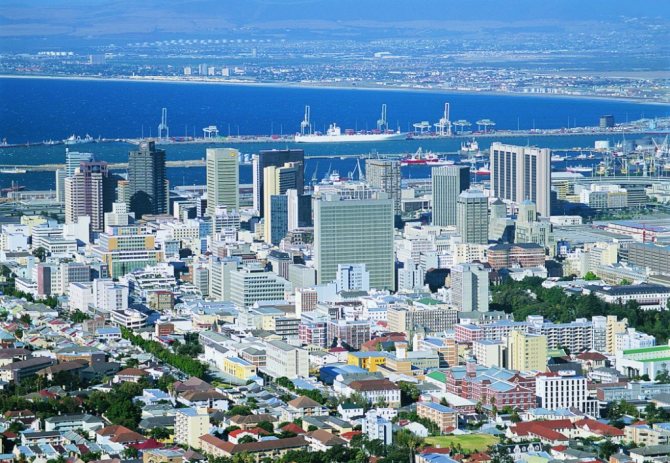
Traditionally, South Africa continues to be the center of immigration from all over the African continent.
Russia is also attractive for migration. In this case, we are talking about the return of a huge number of representatives of the Russian people from the former post-Soviet republics. The reasons for migration can or could be very different - from family reunification (demographic) to military, when ethnic Russians left regions of the former USSR engulfed in armed conflicts (for example, in the 90s from Tajikistan). Labor migration from the former Soviet republics, especially Central Asian ones, also plays an important role.
Migrant supplying regions
The main suppliers of migrants, as in previous years, in 2018 continue to be the Middle East (Syria, Iraq), the states of North-East Africa (Sudan, Ethiopia, Eritrea), as well as West African countries (Liberia, Senegal, Guinea, Sierra Leone). Leone, etc.).
The main reasons prompting the population of these countries to travel outside their borders are military (Syria, Iraq), economic and social (North-East and West Africa).
In terms of labor migration, the main suppliers of labor migrants, usually acting as unskilled labor, are India and Sri Lanka, some countries of Indochina, China, Afghanistan and Pakistan. The lion's share of the labor force, performing mostly menial work, in economically developed countries of the world comes from these regions.
Post-Soviet countries are also a source of labor migration. But in this case we are also talking about other reasons that encourage residents of the republics formed after the collapse of the Soviet Union to travel abroad. For example, many Jews left post-Soviet countries and took advantage of the repatriation program to Israel. Many Germans, Poles, and Finns also returned to their historical homeland under the repatriation program.

Israel is one of the world's immigration centers
Features of migration processes in the Russian Federation
In our country, in recent years, the expected migration increase has not been achieved. This is explained by the fact that there was mainly illegal migration, as well as chaotic migration processes in Russia that did not take into account priority. A modern migrant strives to settle down in large and developed cities, where it is easy to find a decent salary and a job. This situation has worsened migration rates, since some regions of the Federation have a significant surplus of labor, while others have a shortage.
The government considered the solution to be a series of reforms, among which the task was set to redistribute migration flows, and focus on compatriots. The decision taken to focus on repatriation had a number of reasons:
- The migration of the Russian population, in particular former compatriots, guaranteed the return of persons who knew the state language;
- Repatriates are interested in official employment, obtaining citizenship and the right to permanent residence;
- Migrants in Russia who decide to migrate to their historical homeland from abroad usually move as families, which eliminates the possibility of sending large sums of money abroad, and therefore minimizes the flight of capital from the country.
The most attractive countries to live in
For many years, the list of the best countries to live in the world consists of almost the same countries. Places in the rankings change, and the rankings themselves are also different, because countries are assessed according to various parameters. For example, the Human Development Index (HDI) or GDP volume may be taken into account. You can also look at countries from the point of view of ease of immigration.
If we consider countries from the point of view of the comfort of life in them, then in this case we can consider them according to the Quality of Life Index, which is a combined indicator that evaluates the state’s ability to provide a prosperous life for its citizens.
At the end of 2021, Austria tops the ranking of countries in the world in terms of quality of life. This European state is developing steadily, citizens have a high level of social protection, and Austria itself has not suffered much from the European migrant crisis.
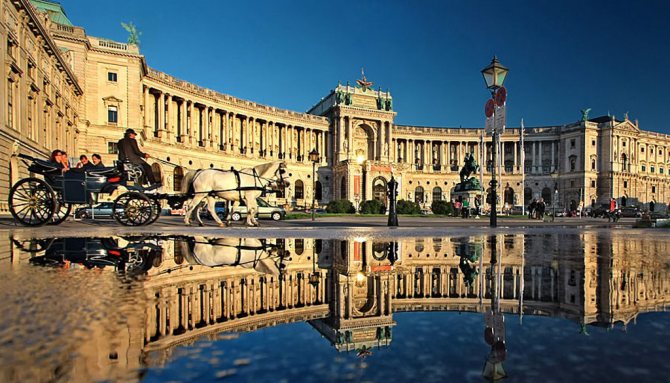
At the end of 2021, Austria tops the ranking of countries in the world in terms of quality of life.
Germany is in second place . This is the strongest European economy, high social protection of the population, the political and economic leader of the European Union.
Third place again belongs to the EU country Denmark. The small European state is attractive for its economic and political stability, democratic principles, as well as the highest culture, just like the two previous countries.
In fourth place in the ranking is distant New Zealand . This remote, small Pacific country is considered the safest place to live in the world, as well as one of the most developed. Over the years, New Zealand has been the destination for many migrants. Among other things, New Zealand is considered one of the most environmentally friendly countries in the world.
Spain is in fifth place. This southern European state is attractive with a stable economy, high wages, the highest level of culture, numerous architectural monuments, a cozy climate and the friendliness of the local population. Most often, people from the CIS countries choose Spain as a country for emigration. In addition, Spanish immigration legislation is considered one of the friendliest among EU countries.
Finland took sixth place. This northern country was able to show miracles of economic growth, has one of the most advanced social protection systems in the world, as well as a well-developed and modern public education system. In all respects, Finland is not far behind previous countries. Finland is also one of the most attractive countries for emigration from post-Soviet republics.
The United States of America is in seventh place. This is the leading economy in the world, a state that millions of migrants from all countries strive to get to. The United States was able to provide its citizens with a high standard of living and social protection. By many indicators, the United States is the world leader. Which, however, does not quite apply to the quality of life.
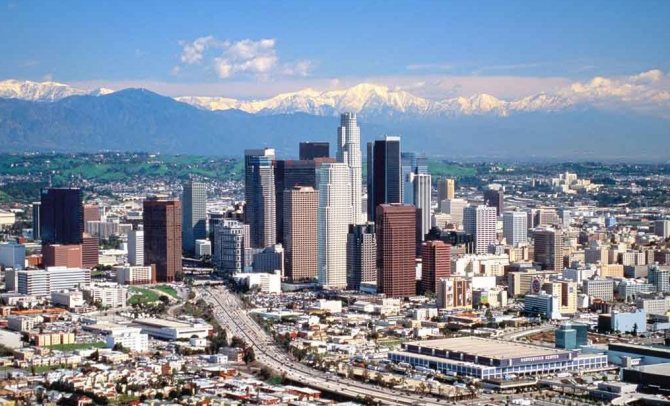
The US ranks seventh in quality of life
European Portugal is in eighth place. This neighbor of Spain is similar in many ways. The Portuguese are well socially protected, provided with work and live in a comfortable climate. Despite certain economic problems of past years, today Portugal shows stable economic growth.
Ninth place went to the Commonwealth of Australia . Australia is considered one of the most developed countries in the world. The continent is surrounded by ocean; the coast of Australia has a wonderful climate. The country's economy is stable and little affected by global economic crises. Australians are well protected from a social point of view.
Slovenia is in last place in the TOP 10 ranking of countries in terms of quality of life. This small Balkan state, formed after the collapse of Yugoslavia, today shows stable rates of economic growth and social development. In addition, Slovenia has a wonderful comfortable climate, a small population and political stability.
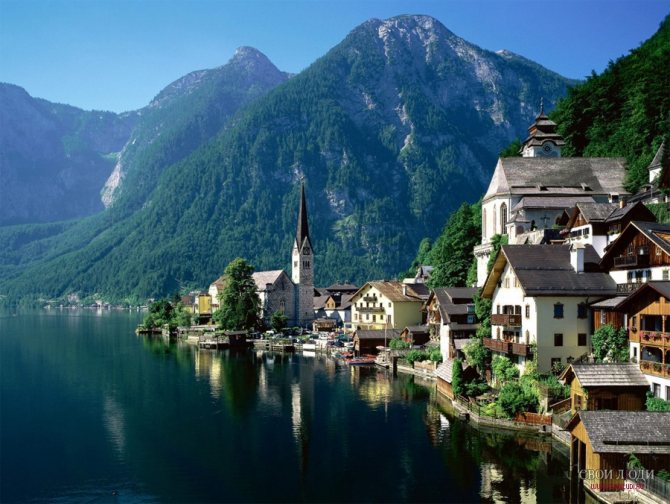
Slovenia today shows stable rates of economic growth and social development, as well as political stability










